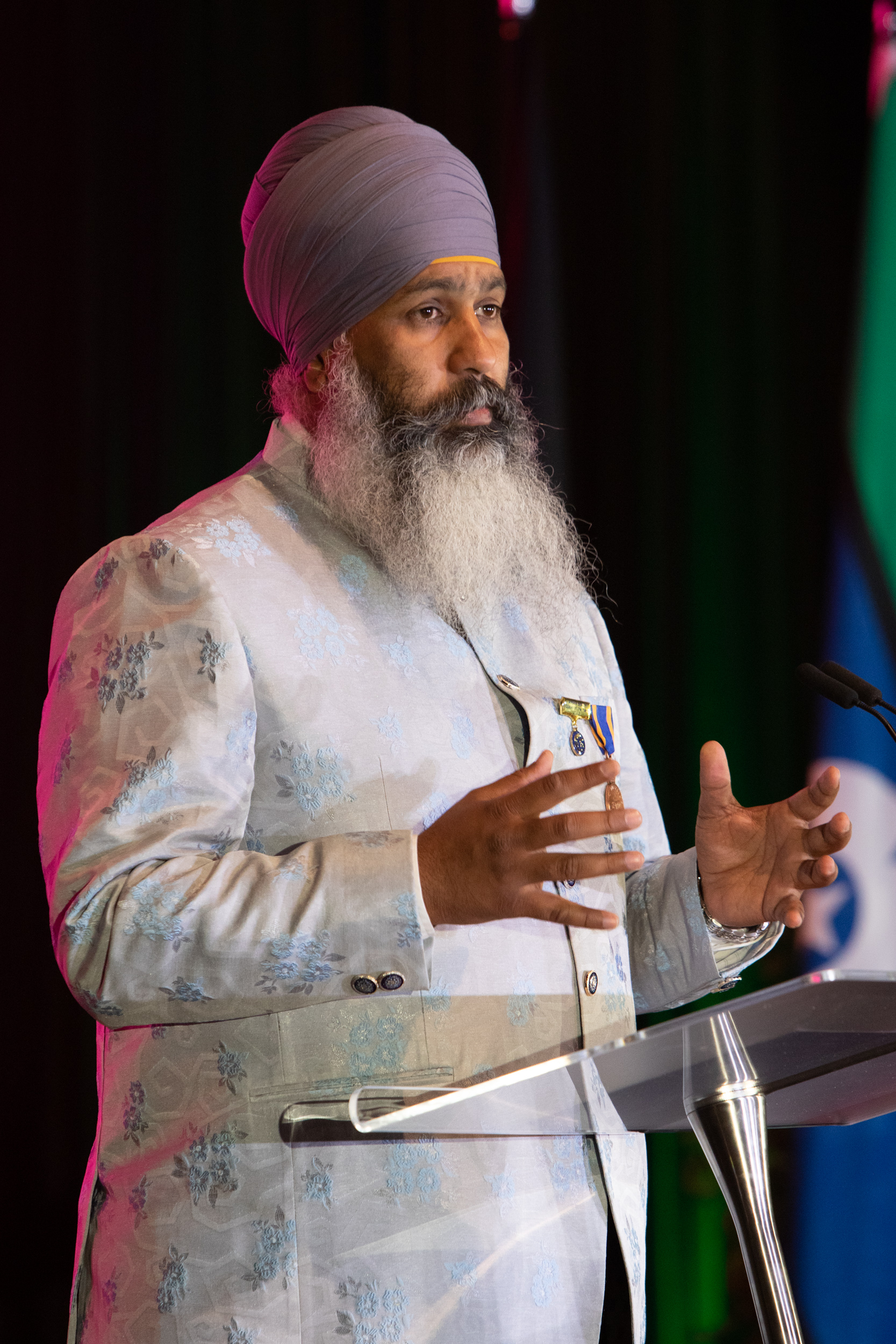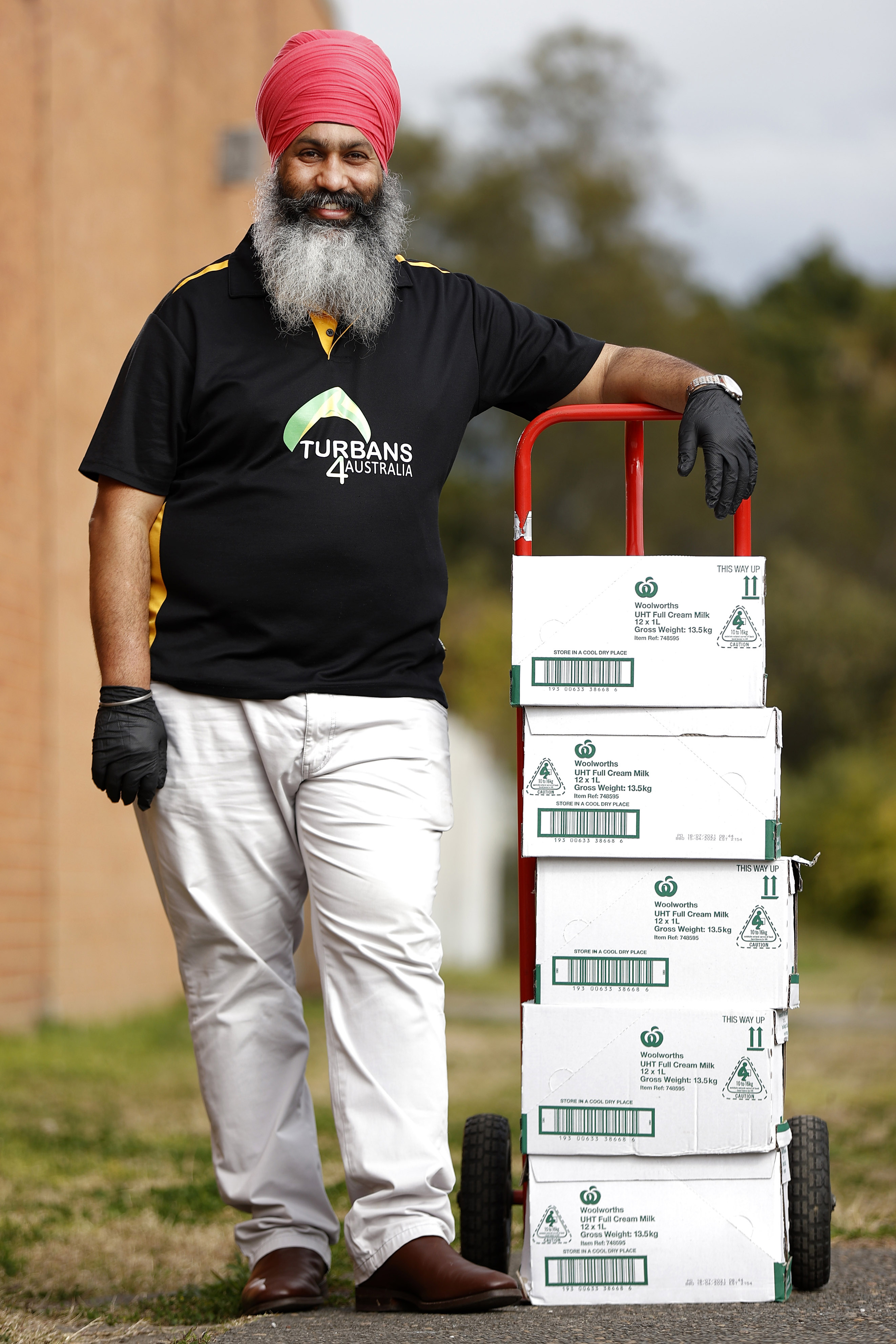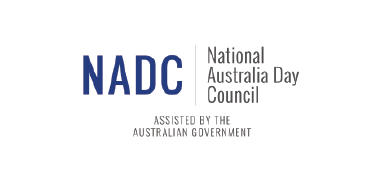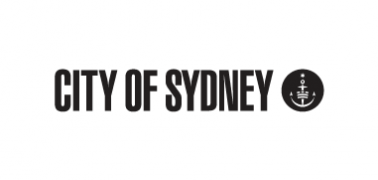Australia Day Address
The 2023 Address was delivered by 2023 NSW Australian of the Year Local Hero Amar Singh on Friday, 20 January at the Rosehill Gardens Racecourse in Western Sydney.
This annual event held in the lead-up to Australia Day provides everyday Australians a unique opportunity to hear from a prominent and inspirational individual as they speak passionately on matters they consider to be of national importance.
Mr Singh, founder of Turbans 4 Australia, delivered a powerful talk in which he detailed his experience of being a migrant to Australia and pushed for a more compassionate and tolerant society.
Watch the 2023 Australia Day Address
Firstly, I would like to acknowledge the traditional owners of this land and their Elders, the Darug people, and the traditional custodians of the land and pay my respect to them, Elders past, present and emerging. I also understand that Australia Day is a difficult time for many First Nations people, and I hope our nation will continue to reflect, come together in the name of prosperity and equality.
I would like to acknowledge Her Excellency the Honourable Margaret Beazley, the Governor of New South Wales, and Mr Dennis Wilson, Mr Andrew Parker, the chair of Australia Council New South Wales, and my fellow Sikhs and Australians of all faiths and backgrounds. Welcome. Thank you.
What a humble feeling it is to be up here today, talking about Australia, a land that was new to me many years ago. I’m deeply honoured to have received this award and acknowledgement, not only for myself but for our community and also our team at Turbans 4 Australia. Isn’t it great to have this event finally in Western Sydney? We’ve gone through the lockdowns; now it’s time to celebrate.
The theme of Australia Day is “Reflect, Respect and Celebrate”. I would like to share some of my story and my dreams for our country following these three ideas.
I came to Australia from Punjab in northern India on 11 August 1998 – it feels like my birthday – with my mother, two older sisters, one older brother. I was just 15 years old – didn’t have any of this grey beard, right? Our life in Australia started out of a suitcase, which we packed with joy for a new beginning. Wrapping up our existence in Punjab, leaving so many family members and friends behind, driving to the airport I was wondering: What was Sydney going to be like? How do people live there? What is school like? How will I make new friends? Well, I have plenty now here.
All of us migrants pack our lives into a suitcase. Many come from well-to-do families. Many come here from refugee camps. We all migrate to make a better life for ourselves. The Asian bread shop, the kebab shop, the woodfired pizza – that’s the diversity, that’s our nation. All the wonderful refugees who come with lived experiences, living in those camps one day getting that visa to travel to Australia, that piece of paper that says finally you can start living your dreams, we never forget the loved ones that we leave behind. We rush to pack those bags in excitement to start a life here and then when we land at one of the airports around Australia, often isolation and loneliness sets in – a new country where you don’t know anyone, and you have to start from scratch. So, I pay my respect to all the migrants who have no choice but to start on menial jobs and today, like the Premier, said own businesses – are multimillion-dollar business owners. They put aside their degrees at that time to put food on the table for their families.
I tell my story today – it might not be the fancy words to describe it. It’s a simple story that comes from the heart, a man who fought for his place in Australian society. It wasn’t all easy. There were times when I wondered: what could I do to stay positive? Of course, our journey starts very early. Many things were set against me: as a child living with the Indian caste system, the barriers and struggles of growing up in a single-parent household. I’m proud to be a single-parent child. Then coming to Australia feeling lonely, experiencing racism, which made me sick to my stomach. There were many times my spirit was tested but never broken.
I went to school at Campbelltown, southwest Sydney, upon reaching Australia. One of my teachers in the high school told me my name apparently was too hard to pronounce. She started calling me David. So, “David”. When I started TAFE a few years later, I thought to myself: if you want to talk to me, I want you to call me by my real name, because that’s my identity, that’s who I am.
I became an Australian citizen in the year 2000 and I’ve been a proud Australian since. And one of my best memories from 2000 was the Olympics over here, the best games ever in Sydney. After high school, I wanted to join the Australian Air Force to do aircraft maintenance engineering, but it was too hard to move out of family. So, I decided to take a local job at a local airline at Bankstown Airport. A few years later, I started my trucking and logistics company, which gave me the freedom to do what I do today.
But in 2001, September 11 happened. A lot changed. Turban-wearing Sikhs stood out. We were suddenly seen as a bad person and a threat to the society because of the way we looked. The first victim of hate crime – and I do want to acknowledge this – was a US Sikh service station owner who was shot. Sikhs in Australia became targets of hate as well, including me. Let’s fast-forward a few years. I remember one particular day in 2014; when I was driving my truck around Sydney, I copped yet another verbal abuse. It was the last straw. I had enough. What can I do? Who will listen to me and why would they care? Is it going to be shut off, just another migrant crying racism, right? Well, I had a Eureka moment. Why don’t I call this guy called Ray Hadley and share my concerns live on air? Mind you, I had no media experience. I had never spoken on such an important issue. A part of me was saying, “Amar, don’t do it. What if it backfires and he tells you to bugger off?” Then I remembered a quote by Napoleon. “Until you spread your wings, you’ll have no idea how far you can fly.” So, a small step for Amar became a giant leap for Australian Sikhs.
Ray took my call, and I described the issues we faced. But I decided to push my luck further. “Ray, have you been to a Sikh temple and why don’t you come and visit our community?” He said, “I would love to but after the footy season.” I remember some in our community getting worried. “Oh, he’s a right-wing radio host. Why would we invite him?” I thought: Why not? If we build walls around our community, how do we expect others to learn about our faith, our values, our culture?
So, it comes the day Ray visited the Sikh temple called the Gurudwara Sahib. Oh boy, what a day it was. He sat with many community leaders, asking questions, pulling his jokes, and then he went to tour the whole temple, and it was a steep learning curve both ways for us and for him. And that’s how it should be. I shared a short story with Ray about how I got called a terrorist at a job in Wollongong just minding my own business. When I rang him to thank him on the show the next day, he said, “Amar, do you mind repeating the story for me?” Guess what? I was gob smacked. The same bloke who had called me a terrorist in Wollongong rang 2GB and apologised. And this is a few months after. What are the chances of that? That moment was the catalyst for me to start setting up a charity that we need to be proud of who we are and where we are today.
I’m a proud Sikh, a migrant and a true‑blue Aussie. I had changed the mind of one person by being open and reaching out. I thought we need to try harder. I was not willing to be the butt of someone’s ignorant jokes. It is about saying no to direct and indirect racism and making casual racist comments and remarks is not a humour because simply a fellow Aussie has a different faith or appearance.
First it was the Greeks and Italians. Then it was the Chinese, then it was the Lebanese and now it’s the Indians. Well, it might be the Africans next. Hold on. Who gets to pick this order? Apart from our First Nations people, we are all migrants. We came here at some stage; from the Ten Pound Poms to the boat refugees, we all came here. I figured out people are scared of the unknown, including our turban. So, the more we open up our hearts and arms to each other, the better things will be. It was the lack of understanding about migrants that I’ve talked about, including the lack of understanding about our Sikh faith and other faith communities, so we have to do something about this.
That led me to form the charity that I called Turbans 4 Australia. I was still working to feed my family but in the back of my mind I wanted to make a difference. I wanted to bring change. Initially, a small bunch of us got together to help the local causes. One criticism that’s often laid on migrant communities is that we always do everything for our own. We should do it too. But you know what? We have a moral responsibility to our Australian society. This is our home. Remember, this is where all our kids are going to grow up. The society we help create today will be our and our kids’ future tomorrow. I wanted to play a role in helping to create a harmonious future and help build bridges.
I never dreamed Turbans 4 Australia would be where we are today. Turbans 4 Australia is an organisation that helps Australians in times of need regardless of their faith, ethnicity, background, religion or life circumstances. We are just a people’s charity. You know, during the drought relief campaign I was shocked to learn how our regional Australians are treated. I think too many of us city‑dwellers don’t realise the importance of farms and our people on the land. After listening to Ray Hadley and Alan Jones speak about the drought, it really bothered me that many of our rural landowners were taking their life because their properties were getting repossessed by the banks. I saw this opportunity to show the practical way of what my Sikh faith teaches me – serve others, [inaudible], actively take part and deliver the hay from Camden to Coonamble, a town I’d never been to, never knew what it was like, but that’s what it is. This is our country. We need to take ownership. It was a way to promote multiculturalism and harmony. I wanted to bring about change and educate the wider society about Aussies from different backgrounds. Living with my values of my Sikh faith, our charitable actions were the perfect way to do it.
In the first few years, we helped out at community sports events, providing free snacks and water – events such as City2Surf, Bondi Splash n’ Dash, Relay for Life and community festivals. Helping out these events gave me a sense of belonging, of ownership that this is my country too. As a resident of southwest Sydney, I hardly get to walk on the white sands of Bondi Beach, but now I call Bondi lifeguards Hoppo and Reidy my mates.
In 2018, [after] a Sikh community event in Liverpool, we found ourselves with about $7,000 left over. With the fires wreaking havoc on the north coast of NSW, I thought: why don’t we use this money to take a truckload of stuff [of] what they need up there? Guess what? That one trip turned into 20 trips, driving up and down the north and south coast of New South Wales with truckloads of supplies while the fires were still running, were still burning. People’s houses were gone, but it was that spirit, that Aussie spirit, that mattered.
In 2019, we went into the COVID lockdown. We started our COVID relief programs. Turbans 4 Australia supplied over 100,000 hot meals and grocery hampers to those who were struggling, from our council kitchen in Liverpool. I want to also acknowledge the contribution of my local councils here in Western Sydney, South West Sydney and interstate, councils such as Paramatta, Liverpool, Penrith, Blacktown, Queanbeyan, Wollongong. They all got behind it – Whittlesea Council in Melbourne. They opened their doors to us. The staff went out of the way to help us, to help the community. That really reinforced the spirit of community and I am really thankful and grateful for all those people.
Soon after the COVID relief programs, we started in Canberra, Wollongong, Dubbo, Gold Coast, Brisbane, Perth. We delivered over 2,000 pallets of food and personal care items during the bushfires, the floods, drought and COVID 19. Since the floods in northern NSW, our trucks and vans have travelled more than 40,000 kays. That’s like driving twice from Sydney to London and back. It’s been one of the longest relief campaigns and still ongoing.
Turbans 4 Australia started with a small group of volunteers. Today we’re a significant force with over 300 national volunteers running our community pantries right across the road here in Clyde, Northern Rivers. Our main drive is to support local communities. Turbans 4 Australia fundraises to buy what we need from the suppliers, then hands it to our regional partners for free. We do not take ownership of the towns. We provide it to people who know the town. It’s funny; some of the towns we go to, I can’t even pronounce the names! That’s okay. That’s how it is. Some of them have very traditional names.
Last year we launched our social enterprise – Green and Gold Charity Logistics. One of the trucks you saw in the video. The trucks help us pick up bulk donations and move them quickly when and where they are needed, because disaster doesn’t give you notice. It just happens like this. [Clicks fingers.]
Another thing Turbans 4 Australia does is organise cultural events, activities and festivals of dance and music. We also hold turban‑tying events. People have three questions: How long is your hair? How long is your turban? And how do you tie it? So make sure all of you today have a turban-tying downstairs. This is what it’s about. We do this to show the groups that turban although is a sacred part of our body, it’s a token of our friendship to you. Because that is how it is. We don’t want anybody to be scared of a turban or a hijab or any faith symbol that Australians wear. We are all equal. Remember we are all one. What we want to do is to create an understanding of our cultural differences but also appreciate and welcome what is unique to each culture – not just Sikhs, but Australians of all races, religions and backgrounds. That is the true spirt of multiculturalism here in our society.
You remember when I was called David at school? Well, guess what? Now I have another issue. Members of our wonderful Arabic community told me numerous times that my name, Amar, means “the moon” in Arabic. I think they are referring to the bald patch under my turban, right! By the way, Sikhs do lose their hair as they age! My wonderful wife, KJ, over there, who loves my cooking by the way, always says, “You have the least hair in the family and yet you make the biggest fuss when you wash it!” You can laugh; it’s not offensive, right.
Our Sikh teachings of respect for all tell us we should treat everyone equally. So back to panth. This is what is indeed one of the most important tenets we live by. Panth meaning everyone – your society, your community, where you live, where you work, where you belong. When people are unable, for whatever reason, to feed their family and meet their most basic needs, for me this is the most important time when we need to show them respect. Our actions to help them should come from a place of dignity and equality. I believe when we are helping anyone, they are on the same level as us. We can’t look down on people just because they are going through a rough patch in life, whether they have experienced the worst floods in history, the worldwide pandemic or the bushfires destroyed their home or just the cost of living, we need to be together. We are in this together. We should respect their loss and in times of need we do our best to serve them respectfully, to provide assistance in their time of need. As a practising member of a religious community, it is my dream to see Australians from all faiths and backgrounds treated equally and respectfully.
Australian Sikhs love to celebrate! We have many festivals throughout the year: the Diwali festival of light; Vaisakhi, the harvest festival; the birth of Khalsa. What Sikhs in Australia really love is to celebrate our humanity. Each and every one of us deserves to be celebrated for who we are, not to be made to feel excluded either by colour, religion or what we have and what we don’t have. I would also urge various multicultural communities to learn about other communities as well. Learning is a two‑way street. If we expect others to know and respect our culture, we must do the same for them. Please join me as we express our love for humanity and our love for Australia.
I am especially pleased to receive this honour of being named the 2023 New South Wales Local Hero. Thank you. If you’d said to me back in my days of driving trucks down James Ruse Drive that one day I’d be here doing this address, I would have laughed and said, “What drugs are you on, mate? This doesn’t happen.” But here I am today. The wonderful story of Australia – you can be anyone, anything, anywhere in life as long as you put in the hard yards.
I want to give a heartfelt thank you to the Australian media who have promoted our work, promoted our projects to people far and wide. Just the other day I got a thankyou letter and a cheque from Perth, so that’s how connected we are. My journey doesn’t end here, though. My dream is to see Turbans 4 Australia grow into a national charity with warehouses set up across our states to help people in need. When we first leased our warehouse in Clyde, our team was saying, “Hey, this is too big”, and now we haven’t got room to store things. So, we need to build a bigger warehouse, hopefully soon. But we want to rescue products. Instead of them going to landfill, that can be utilised in times of disaster. That is where my trucking experience comes in. Minister, this is where you might announce some funding. Just kidding!
I really want to thank the Australian public who have supported us, believed in us, from the lady in Eastlakes who rang me one time to say, “I want to donate to you $50. That’s all I have until my next pension.” And I said, “Thank you so much. You can put it in our bank.” She goes, “I’m 80, love. I don’t have internet banking. You’re going to have to come pick it from me.” That $50 is like a million dollars to us – the faith that lady put in us for what we could do.
If it wasn’t for the love and the prayers of our fellow man, we wouldn’t have achieved what we have and had the impact so far. But of course, the New South Wales Local Hero Award is not just for me. It is an acknowledgement of my fellow volunteers, my team members, our families, when we go into the lockdowns, to the Australian community who help us do the next bit – it’s all a big jigsaw puzzle. Every piece joins in and every piece is important.
I see so many faces here that I know. Maybe I haven’t said it enough, but thank you for your support, your love and your kindness and understanding. We are all bonded not by blood but by a universal brotherhood and sisterhood.
This award shows the rich diversity of our nation. We are a better, stronger nation when we include and support one another. The deepest respect I have for the institutions and organisations that work on the grassroots.
Today I have shared a small part of my journey in life so far. You’ll need to write your own story in your own way in your own words. Life is waiting for you to happen. Be part of the change and the solution. It’s not just easy to sit around and talk about the problems. You need to take actions. I urge everyone to be kind and respectful. Let’s make Australia a nation that welcomes people and values people from all walks of life, from our First Nations people who have cared for this land for over 60,000 [years], to our recent arrivals, somebody that is landing right now at an airport around Sydney, starting their suitcase journey again.
The hardest thing for me, you know, was to write and deliver this speech. I’m still nervous. I’m better at getting trucks loaded on the go when I’m gone for two days - that’s me. For us it’s helping our friends in need, mates helping mates.
Thank you and have a good Australia Day.





